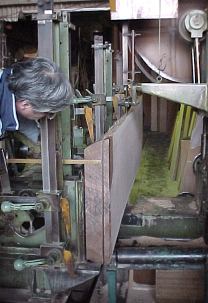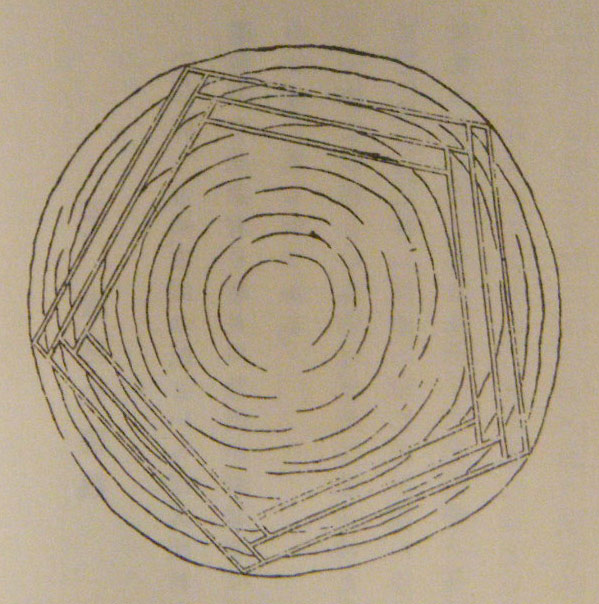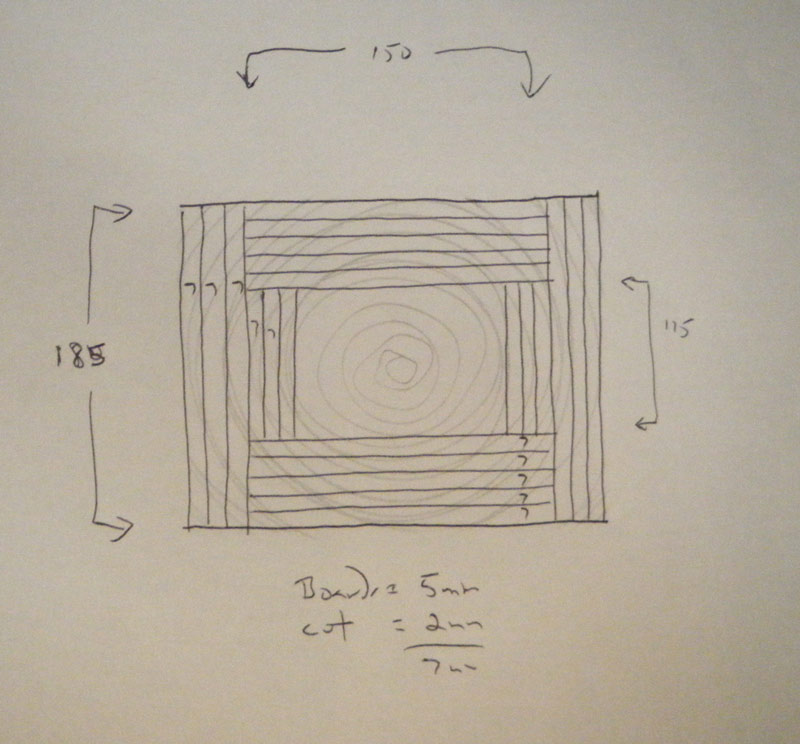« How are we doing? Part three ... | Front Page | Print Party video! »
The Wood Question ...
Posted by Dave Bull on May 4, 2016 [Permalink]
Lots of people offering assistance here ... there's not much our overseas friends can do about paper, but a few people have suggestions about the wood supply ...
Let me give a bit more background about our wood. Modern printmakers - trying to get different effects in their prints - can of course use 'any' wood, but for us, it would only be as an absolute last resort that we would use something else. Given that we are trying to make prints equivalent to what was produced in the Meiji-era, the 'best' approach is to try and use tools/materials that are as close as possible to the original materials.
From our point of view here, there are a few things about the wood that are absolutely critical:
- it must be yamazakura; simply no other species gives the same effect when printing (more about this below)
- it must be selected ... some wood is of a suitable density and grain, some is not ...
- the way that the raw material is cut from the log is very important to the results
- it must be very carefully and properly dried
- it must be planed and dressed to an absolutely smooth mirror finish
These days, it's very common to hear of some resource that has been 'fished out' (whether fish, or whatever ...) ... and the product is simply unobtainable. Somebody who wants to utilize that resource simply has no choice; they have to find an alternative. In our case - the yamazakura - it's exactly the other way around. It's not that all the 'good' trees are gone; there are plenty of them up in the mountains, living out their normal life-span, and falling over when they get to the end of life. The problem is that with so little demand for the blocks for traditional woodblock printmaking, the supply chain has disappeared.
In the previous post, I wrote about making a trip to the lumber markets back in 1999 after Shimano-san passed away. I was looking for some yamazakura, and I came across this pile of wood in one of the wholesaler's warehouses (it's hard to get the scale of this photo; these things are big - about 4 meters long ...):

He said it was yamazakura, and that it had been there for 'at least a couple of years'. I paid him 400,000 yen (around $3500) for the plank at the bottom of the pile (the widest one), and he ran it around to a local re-saw shop and had it sliced into 4 planks.

We trucked it out to my home in Hamura (moving it to Ome later), and there it sat, being occasionally turned and re-stacked. There was no 'panic' to start using it, because by then Matsumura-san had jumped into the wood business, and we began to use his products.
But as I wrote in the previous post, the quality of his products over the years really began to decay steeply, and sometime around 2014, one of the batches of wood we received was so bad that we decided to go ahead and use one of these planks, now very nicely aged indeed. We chopped it up into manageable pieces, and sent them out to a carpenter who had good skill with a plane, who could dress them for us.
He returned them to us a few days later, "I don't know where you got this stuff, but you do know that it isn't yamazakura, right?"
Umm. It was clearly cherry, but the grain patterns were a bit different, now that they were visible. We tried it anyway ... and no, it was unusable. The pores in this sub-species were so large and fat that each of the planed pieces had a palpable series of grooves on the dressed surface, and these grooves showed in our test printing.
400,000 yen ... and nearly 15 years of drying time ... wasted. Whether that dealer knew it wasn't yamazakura - and took me for a ride - or whether he too didn't understand, I'll never know. Anyway, back to square one.
Before I move on, to talk about what we are going to try next, let me show you an image I have copied from a book on traditional printmaking techniques published in about 1929. It shows the proper way of cutting slabs for making ukiyo-e prints from a large cherry log:

This cutting pattern gives the maximum amount of wood with a 'flat' grain. These days, of course, no lumber dealer in their right mind would cut a log this way. These boards tend to warp a lot (immediately after being 'released from the log), and their customers - furniture makers for the most part - want straight grain, which is more stable and more decorative. They want wood that has been quarter sawn - like this (image borrowed from an Australian lumber dealer here):

Great for furniture, awful for us. What we need are the wide areas of smooth clear wood that result from flat-sawn boards. We deal with the warping by cutting them fairly thick to begin with, then dressing them down to requirements after they have dried and stabilised.
So do I have to try and find an entire cherry log, then saw it up in the old way? There is absolutely no way that I can invest the many thousands of dollars that would be required to do such a thing - even if we could find such a log on the market.
But we are lucky in one respect that most of the work we are doing here at Mokuhankan these days is of a fairly small scale. We don't need the wide boards that are required when making typical ukiyo-e prints. Our current subscription prints need only 15 cm in width, Jed's Ukiyoe Heroes prints need boards of about 18 cm, and our HangaClub editions use wood just under 12cm wide.
So we have come up with an idea. I don't need a 'log', but if I can find a chunk of good-looking yamazakura of somewhere around 20 cm x 20 cm, and about 25 cm long (or longer) ... not an impossible task, I think, we could get it sliced in this pattern pretty easily (sorry, this quick sketch isn't scaled very well, but you get the idea ...):

This would give us a handful of thin flat-sawn boards, with no vertical grain at all. We could then dry these thoroughly in a fairly short time (as they are so thin), then bond them to a strong birch-ply base, and dress the surfaces ready for carving and printing.
Next step - as soon as I can get away from the shop for a day - over to the giant lumber market at Kiba and start searching!
Added by: Tom on May 5, 2016, 6:43 pm
As a last resort you could use a bandsaw to cut the backs off your stock of carved blocks and glue these to a ply base, at least that way you know the timber is good.
When you cut a plank from a log all sorts of tension is released from the timber and movement can be expected, it might actually be better to glue your face down quickly rather than leave it to "dry".
I would experiment with laying up your ply, there could be a need to balance the board. Putting a 5mm layer of cherry onto an existing ply in the hope that the base will prevent cupping and splitting may be problematic. Usually plywood has a top and bottom that exert opposite forces on the core, so a 5 mm top might need to be balanced with similar on the bottom - at least that is what I was told by the man who made my plywood, he convinced me to veneer both sides of the board, admittedly I was using a soft core. I guess it will work if the base is stronger than the face.
Good Luck Dave!

Added by: Dave on May 5, 2016, 6:55 pm
Tom, thanks for the thoughts and suggestions.
There is no way that we would ever try this with a single face - we would always balance it by bonding to both sides.
As for the immediate bonding, I think that would leave us susceptible to cracking down the road; if we bonded it quickly (before it had properly dried) then as it did dry out over the months/years I think it would quite likely develop cracks, as the cells began to shrink over time. I think it would be better to let it dry - tightly tied down in stacks with stringers inbetween. Any pieces that developed a wildly uncontrollable warp that couldn't be held down by glue would be discarded ...
And the question of using the back of my old blocks ... that's a kind of 'nuclear option' for us. Most of my old colour blocks are carved on both sides, but nearly all the key blocks use a single face only. In theory, we could re-saw these, then bond the two pieces (the carved face, and the unused face) to new bases (in pairs, as mentioned above) and use them that way.
But if that carved face shrunk or distorted by as much as a fraction of a millimetre while doing this, it would be a total disaster for that print. The colour blocks could be thrown completely out of alignment.
As things stand right now, I'm not really willing to risk this. Further down the road, if our supply really does come up short after all other options ... then perhaps we may have to give this a shot!
(I know that Adachi has done this in the past - they have re-used wood from prints that they took out of their catalogue, either because the blocks were too worn to use, or because that image wasn't selling. They sent a huge pile of blocks over to Matsumura-san to be planed down (from both sides) to a central flat 'core', with these then being bonded to a fresh plywood base for re-use.)

Added by: Petrik on May 5, 2016, 7:40 pm
For the overseas people is it not feasible to set up a Paypal donation system? We may not be able to provide physical help but you're going to need a lot of financing for all of this too and overseas supporters could certainly help there.
As for the paper, could this be made outside of Japan? I know there's a paper maker in the Netherlands creating paper for artists. I'm actually heading to the Netherlands in about a month and it's on my to do list to visit them. FYI their website is http://www.schutpapier.nl/
On the topic of the wood, I do have a bandsaw with resawing blade but no cherry trees of that variety here as far as I know. ;-)

Added by: Nathan on May 7, 2016, 2:24 am
I know this is going to sound crazy: But do you even need wood?
There are a lot of high-density synthetic materials these days; perhaps one of them might work. They have no pores or wood grain to worry about so you could get a completely flat surface. Also, since they don't absorb moisture, warping would not be an issue.
I know you have tried to keep things as traditional as you can; I respect that a lot. But you have also proved that you are willing to try new things, to experiment and innovate. If the old ways are no longer viable, perhaps it's time to try something new.

Added by: Dave on May 7, 2016, 8:20 am
But do you even need wood?
For the key blocks, metal is certainly a possibility. Many of the old Meiji-era kuchi-e were made with electrotyped key blocks, and then in the 20th century, the Yoshida family used zinc plates for many of their key blocks. That's doable.
But it's the colour blocks that are giving us the biggest problem, and when you mention 'they don't absorb moisture' this would be a deal-killer for us. The cherry blocks we need have to strike a balance between two competing factors: hardness and density on the one hand (to allow fine carving, along with durability), and good absorbability on the other (to allow the pigment mix to soak in well, and then be released into the paper under the pressure of the printing pad).
I myself am very open to the 'innovation' aspect of all this, and if something came along that would cover both of those requirements, I'd be willing to try ...

Added by: donald on August 3, 2016, 2:32 am
What is the name of the woodblock printing technique book from 1929? I am dying to know.
I also understand that prunus sargentii wood is similar to yamazakura.

Added by: Dave on August 3, 2016, 7:47 am
The book is a Japanese publication:錦絵ã®å½«ã¨æ‘º (Nishiki-e no Hori to Suri) "The carving and printing of Nishiki-e", by Ishii Kendo. The ISBN is 978-4753801596 I'm not aware of a translation, but much of the material in this volume was incorporated into a large Japanese Encyclopaedia some years ago: 原色浮世絵大百科辞典 (Genshoku Ukiyo-e Daihyakka Jiten) "Grand encyclopedia of Ukiyo-e work in original colours" published by Taishukan in the early 1980s.

Add Your Input